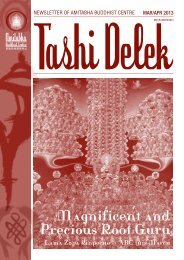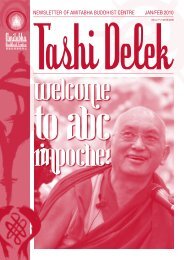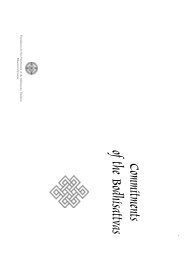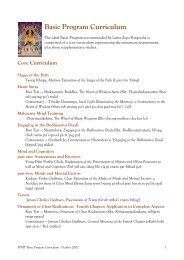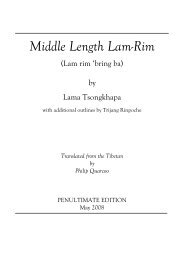How to Generate Bodhicitta (English) - Amitabha Buddhist Centre
How to Generate Bodhicitta (English) - Amitabha Buddhist Centre
How to Generate Bodhicitta (English) - Amitabha Buddhist Centre
Create successful ePaper yourself
Turn your PDF publications into a flip-book with our unique Google optimized e-Paper software.
So while you are training, in your actual meditation and throughout all your daily activities, you shouldcontinuously recite this verse. These words from The Guru Puja are so powerful, so full of blessings, that it isindeed very important <strong>to</strong> recite them all the time. There is even a practice of accumulating one hundredthousand repetitions of this verse while meditating, and this would be an excellent practice <strong>to</strong> do.In the prayer, you first entreat the lama by saying, "O venerable, compassionate Guru," and then you say,"bless me—may all the sufferings and negativities of all the precious mother sentient beings ripen on me rightnow, without exception. And bless me <strong>to</strong> give all my roots of virtue and goodness <strong>to</strong> others, so that these mayripen upon them." The verse concludes with the prayer: "may all sentient beings have happiness." This isreally an exceptional, powerful prayer.It has become a tradition that when The Guru Puja is recited, this verse is repeated three times. This traditionwas initiated by Lama Pabongka Dorje Chang. Before his time, The Guru Puja would be recited straight fromthe beginning <strong>to</strong> the end, but because he placed so much importance on this verse, he began the practice ofreciting it three times. So the fact that this tradition has continued up <strong>to</strong> now is due <strong>to</strong> the kindness of LamaDorje Chang.Practising Giving and Taking with the BreathThe next verse in the root text says, "These two, taking and giving, should be made <strong>to</strong> ride on the breath."This means that after you have become familiar and proficient with the meditation as explained, then youshould combine the meditation with your breathing. The way <strong>to</strong> do this is as follows: while you are breathingout, think that you breathe out all your goodness, and this transforms in<strong>to</strong> whatever is needed for the benefi<strong>to</strong>f sentient beings. You breathe whatever goodness there is within you—your body, virtues, richness, and soforth—and this transforms in<strong>to</strong> whatever benefits all sentient beings.Then, when you breathe in, think that along with the flow of your breath come all the sufferings of all sentientbeings in the form of black light. These sufferings in the aspect of black light enter you and go straight <strong>to</strong> thesource of all the negativities and sufferings you have experienced since beginningless time—your egoistic,self-cherishing thought—and they ripen right there, in your heart. Your see, the mind and the breath areinseparable. The mind rides on the breath, so this visualisation that combines giving and taking with thebreathing becomes a powerful cause for generating bodhicitta. It's also similar <strong>to</strong> the vajra recitation which isfound in the practice of highest yoga tantra.It is very beneficial <strong>to</strong> do this practice as you are going <strong>to</strong> sleep. Before you go <strong>to</strong> sleep, generate the though<strong>to</strong>f love and do the visualisation of giving while breathing out; then with the thought of compassion do thevisualisation of taking while breathing in. If you go <strong>to</strong> sleep doing this practice, then the whole time you areasleep, especially if you like <strong>to</strong> sleep a lot—until eight or nine in the morning!As for myself, the more i progress in years, the more I need <strong>to</strong> sleep, and also my sleep gets deeper. Butwhen I was young and studying at Sera Monastery, I had the habit of staying up all night. The night is verylong and you can do so many things—you can do prayers, read texts, whatever you want <strong>to</strong> do. In the earlymorning, at dawn, I would feel so happy. My mind would feel very fresh and I would rejoice from the depths ofmy heart, thinking, "<strong>How</strong> lucky I am! I was up all night and was able <strong>to</strong> do these things while the majority of thepeople around me were asleep." I would consider myself so fortunate <strong>to</strong> be able <strong>to</strong> stay up all night andpractise. This is something Venerable Lama Thubten Zopa Rinpoche does. But now, as I grow older, I needmore sleep, so I am unable <strong>to</strong> stay awake all night even if I want <strong>to</strong>.I really want <strong>to</strong> stress the importance of transforming sleep in<strong>to</strong> virtuous practice because if you calculate theway you spend your life, almost half of it is spent sleeping. Therefore it becomes very crucial that the time youspend sleeping becomes virtuous practice, doesn't it?In his Songs of Experience, Milarepa said, "At night, sometimes I sleep, and when I sleep I practise mergingsleep with the clear light, because I have received instructions on the clear light of sleep. Other people do nothave these instructions—how lucky I am!" There are very few people who are actually able <strong>to</strong> merge sleepwith the clear light practice, so for the majority of us who are beginners, it is extremely practical and useful <strong>to</strong>go <strong>to</strong> sleep while meditating on giving and taking. In this way, the entire time you spend sleeping becomes theactual practice of <strong>to</strong>ng-len, and thus becomes virtuous.






